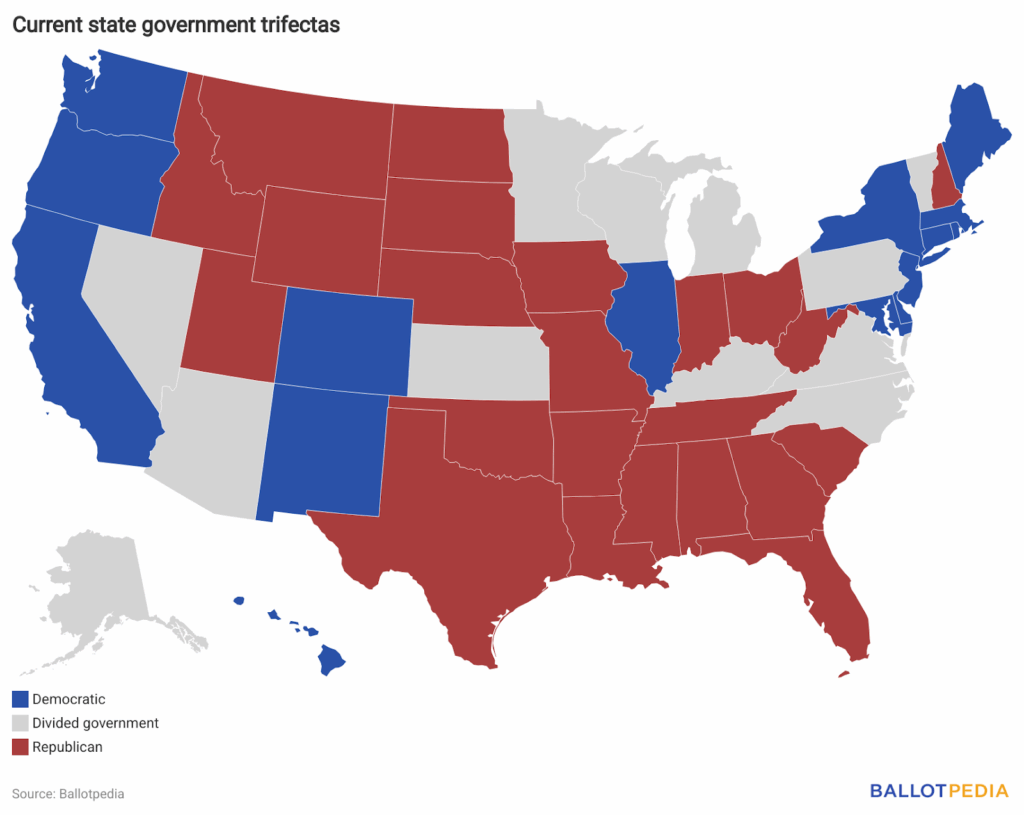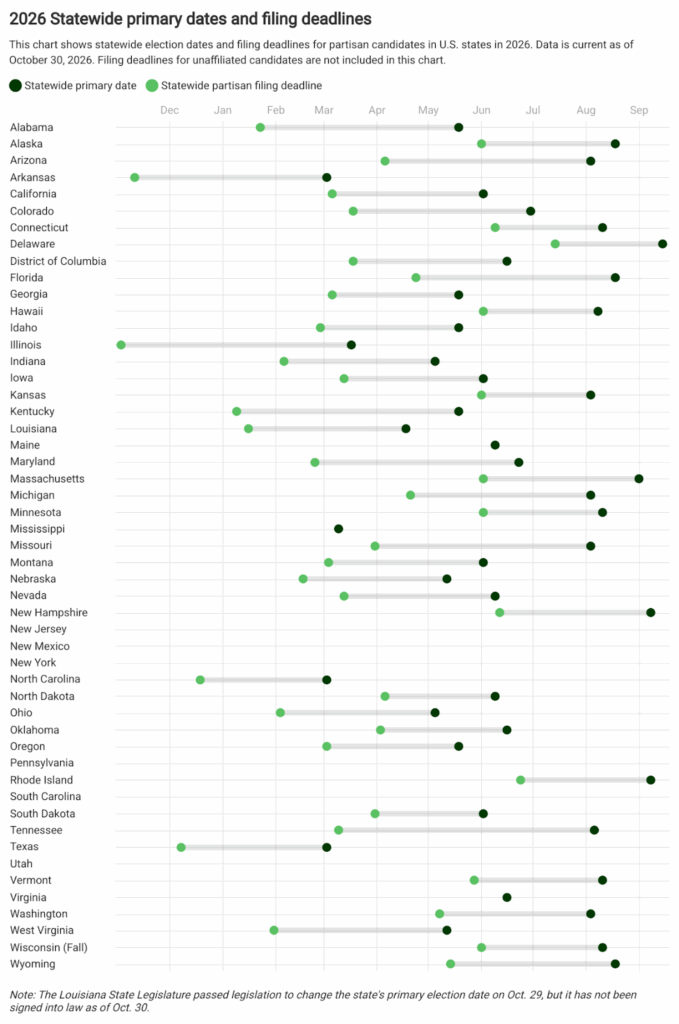Welcome to the Friday, Oct. 31, Brew.
By: Briana Ryan
Here’s what’s in store for you as you start your day:
- A look at the state legislative elections happening in New Jersey and Virginia on Nov. 4
- Covering Prop. 50 — Robust information in action, by Leslie Graves, Ballotpedia Founder and CEO
- Forty-one states have confirmed candidate filing deadlines for their 2026 statewide primaries
A look at the state legislative elections happening in New Jersey and Virginia on Nov. 4
There is less than a week to go until Election Day, and Ballotpedia will cover more than 10,000 elections on Nov. 4. To help our readers understand what's at stake, the Daily Brew will feature previews of key elections from now through Election Day. To see what elections we're covering in your area, check out our Sample Ballot Lookup Tool.
Today, we're looking at the two states—New Jersey and Virginia—holding state legislative elections this year. Click below to see our previews on:
- Mayoral elections
- Local battleground elections
- Statewide ballot measures
- Local ballot measures
- Downballot statewide office elections
- Gubernatorial elections
- Congressional and state legislative special elections
All 80 seats in the New Jersey General Assembly and all 100 seats in the Virginia House of Delegates are up for election. Elections there represent 180 (or 2.4%) of the country's 7,386 state legislative seats. Currently, Democrats have a 52-28 majority in New Jersey and a 51-48 majority with one vacancy in Virginia.
In New Jersey, Republicans must win 13 seats to win control of the chamber. Democrats can only afford to lose 11 seats and retain control of the chamber.
In Virginia, Republicans must win three seats to win control of the chamber. Democrats can not afford to lose any seats and retain control of the chamber.
State government trifecta status
Both states are also holding gubernatorial elections, meaning support for major-party gubernatorial candidates could generate a coattail effect for downballot candidates of the same party. State government trifecta status is also at stake in this year’s elections.
New Jersey is one of 15 states with a Democratic trifecta, meaning Democrats control both legislative chambers and the governorship. If Republicans win control of the General Assembly or the governor’s office, New Jersey would become a divided government.
Virginia is one of 12 states with a divided government, because Democrats control both legislative chambers and Republicans control the governorship. If Democrats retain control of the House and win the governor's office, Virginia will become a Democratic trifecta.
Because there are no state Senate elections in either state, Republicans cannot win control of those chambers, meaning they cannot gain any trifectas in 2025.

Competitiveness
In this year's Annual State Legislative Competitiveness Report, we found that this year's state legislative elections are the second-most competitive of any odd year since 2011. We use three factors to determine state legislative competitiveness: open seats, incumbents in contested primaries, and major party competition.
Looking at those three factors this year:
- Eight seats are open (4.4%). That's the lowest by percentage of open seats in any odd-year cycle since 2011.
- Thirty-eight incumbents faced contested primaries (22.1%). That's above the average of 21.0% since 2011.
- Candidates from both major parties are contesting 158 seats (87.8%). That's the second-highest percentage after 92.7% in 2021.
Click here to read more about this year’s state legislative elections.
Covering Prop. 50 — Robust information in action

Ballot measures are in Ballotpedia’s name and in our DNA. Providing one-stop coverage for the questions, propositions, and measures on state and local ballots was our first foray into providing voters with robust information, and it remains so today.
That’s never been more true than for one of the more intriguing ballot measures voters will decide on Nov. 4: California'sProposition 50.
For more insight into what is happening in California, and in other states, I turned to Ballotpedia's ballot measures expert, Ryan Byrne.
Ryan told me that, in Prop. 50’s case, voters are being asked to make a constitutional change that would approve a“Legislature-drawn congressional map through 2030, replacing the map adopted after the 2020 census.” The goal of the new congressional map is “to improve Democrats’ chances of winning in several districts, including five that currently have a Republican House member – Districts 1, 3, 22, 41, and 48.”
Ryan said Prop. 50 is California’s response to changes Texas lawmakers made to that state’s congressional districts in August. “The new Texas map is projected to net Republicans five additional House seats. Missouri also redrew its map to split Kansas City into three districts, creating another Republican seat.”
That makes Prop. 50, then, the first opportunity voters will have to weigh in on this wave of midterm redistricting. And that may help explain why Prop. 50 has a different feel from your typical ballot measure campaign.
Ryan said what’s surprised him most about Prop. 50 “is the strategy and money behind it.”
“The support campaign is treating this like a turnout election. Typically, ballot measure campaigns aim to establish broad, cross-cutting coalitions and steer clear of overtly partisan framing. Proposition 50 supporters appear to be focusing on turning out Democratic and Democratic-leaning voters.”
Ryan thinks the reason behind that approach is that “statewide special elections on ballot measures have historically drawn the lowest turnout of any November statewide contests in California since 2000.”
The money flowing into the campaigns for and against the measure is unusual, too. Ryan said the campaign supporting Prop. 50 “has raised a large number of smaller contributions, with about half coming from outside California. That’s the reverse of the typical pattern, where small donors are local and large out-of-state donors, often policy-focused nonprofits, provide the bulk of outside money.”
“This shift highlights how deeply Proposition 50 is tied to the national redistricting fight,” Ryan said. “Democrats view it as a major opportunity, and the campaign has tapped into the party’s base beyond California’s borders, at least to a higher degree than is typical with ballot measures.”
Prop. 50’s opponents are taking different approaches. “On the opposition side, two major PACs are leading the effort. One is tied to Kevin McCarthy and a former California GOP chair, and its messaging is aimed at voters who dislike Gov. Gavin Newsom. The other PAC, funded almost entirely by Charles Munger Jr., avoids mentioning Newsom or Democrats on its website and instead focuses on preserving the existing redistricting system,” Ryan said.
Ryan said our Prop. 50 coverage “goes beyond our standard approach.” Among the highlights is a “detailed analysis of the congressional districts we created with our Geographic Information System (GIS) expert to compare existing precinct data under both the current and proposed maps.”
Ryan said what makes our approach different from anything else you may see about Prop. 50 is that “our page is continuously updated as a living record, and it’s connected to related content across the site.”
In short, we’re connecting people directly to the politics of the moment — helping them follow and understand it in real time. That’s a powerful example of what we mean by robust information.
Forty-one states have confirmed candidate filing deadlines for their 2026 statewide primaries
The 2026 election season is quickly approaching. Since our last update, several states have confirmed their 2026 statewide primary dates or candidate filing deadlines.
Forty-one states, Guam, and the District of Columbia have confirmed their 2026 candidate filing deadlines for major party candidates.
Illinois has the earliest 2026 candidate filing deadline, Nov. 3, 2025. Delaware has the latest confirmed candidate filing deadline, July 14. In the 2024 cycle, Alabama's filing deadline was the earliest, Nov. 10, 2023, and both Delaware and North Dakota were the latest, Sept. 3.
The following states have yet to confirm their 2026 candidate filing deadlines: Maine, Mississippi, New Jersey, New Mexico, New York, Pennsylvania, South Carolina, Utah, and Virginia.
Forty-four states, Guam, and the District of Columbia have confirmed the dates for their 2026 statewide primaries through the release of an official election calendar, enacted legislation, or candidate filing instructions.
Arkansas, North Carolina, and Texas all share the earliest 2026 statewide primary date, which is March 3. Louisiana will hold the latest statewide primary on Nov. 3 due to its unique majority-vote system. In 2024, Alabama, Arkansas, California, North Carolina, and Texas all shared the earliest 2024 statewide primary date, which was March 5.
On Oct. 29, the Louisiana Legislature passed SB1, a bill changing the state's primary election date and candidate filing deadline. As of Oct. 30, Louisiana Gov. Jeff Landry (R) had not signed the bill.
The following states have not announced their statewide primary dates: New Jersey, New Mexico, New York, Pennsylvania, South Carolina, and Utah.
Candidates must meet various state-specific filing requirements and deadlines to run for office. These regulations, known as ballot access laws, may include collecting petition signatures, paying filing fees, or both.
Of the states with both confirmed primary dates and candidate filing deadlines, the state with the largest difference between the two dates is Tennessee, at 149 days. Connecticut, Delaware, and South Dakota share the shortest time period between their primaries and candidate filing deadlines, at 63 days.

Click here to read more about the 2026 election dates.

